Catocala of Indiana
|
|
Updated as per "Systematics of moths in the genus Catocala (Lepidoptera, Erebidae) IV. Nomenclatorial stabilization of the Nearctic fauna, with a revised synonymic check list"; ZooKeys 39: 37–83 (2010) by Lawrence F. Gall, David C. Hawks; March 21, 2010 Updated as per collecting data posted on Insectnet.com by Leroy Koehn (Harrison County); June 21, 2014 Updated as per collecting data sent to me by Tim Loeffler (Whitley County); July 13, 2018 |
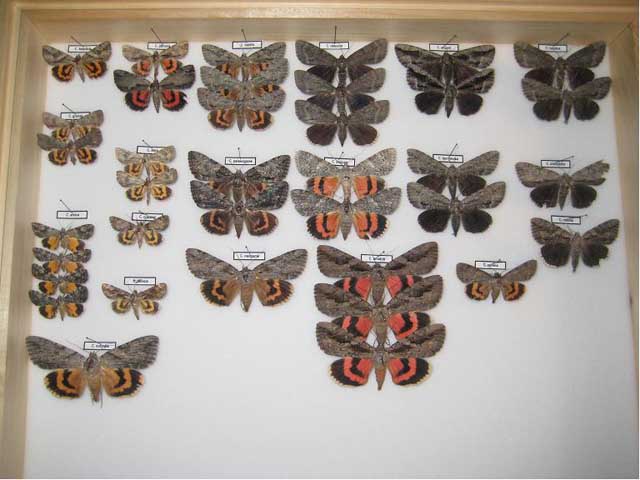
Most recently Scott Mescher of Portland, Jay County, Indiana, has sent me a list of species collected by him in summer of 2009. I am updating Scott's initial list as he reports additional sightings:
amatrix, amica, angusi, blandula?, cara, crataegi, grynea, habilis, ilia, insolabilis, lacrymosa, minuta, mira, neogama, obscura - many 40 to 50, palaeogama, piatrix, residua - many 35 to 40, retecta, maestosa, nebulosa, serena, subnata, ultronia, unijuga and vidua.
Scott writes, "These were all collected by mv in my back yard with lots of hickory, poplar, oak, and willow trees. I have not had any luck with sugaring as of yet."
Most recently, September, 2009, Scott adds cara and vidua to his list.
On September 24, Scott writes, "Just when I thought the season was over, the big boys show up. Lots of maestosa and piatrix along with some amatrix. I caught an ilia last night and a nebulosa tonight along with what I think are 2 luctuosa (68mm & 71mm) which are more creamy brown-yellow than the gray retecta. As soon as they are dry I will send pictures. I can see right now that I will be very busy this fall spreading and taking pictures.
"Well I'm off again to check on a few more lights as my yard is only producing habilis and most of the hickory feeders are done in this area."
The thumbnail section of this page is inpsired by and dedicated to Scott Mescher for his interest in this genus. He indicates he will be sending data and additional images when he has time. Hopefully the thumbnail checklist with descriptions will help with identifications.
I, Bill Oehlke, am very interested in receiving and displaying electronic images of Catocala eggs, larvae, pupae and adults. Submissions can be sent to me via email by clicking on my name. It is ideal to have data (date, time, precise location, wingspan, response to bait or light (MV or black)) when you send images. All images displayed on my website remain the property of respective photographers and are credited to those photographers.
I am happy to try to assist with determinations and like to display high quality images of live moths as well as set moths. If you do take specimens, it is also great to receive verso images of same.
Leroy Koehn has confirmed some species in Harrison County in June 2014.
Tim Loeffler reports the following species in Whitley County: C. amatrix; C. neogama; C. parta; C. grynea; C. habilis; C. relicta; C. vidua; C. ultronia.
Tim has recently (July 13, 2018) sent me an updated and much more extensive list:
He writes: "The numbers are of total specimens seen over the past 3 years (2016-2018).
Small:
C. clintonii - 3
C. grynea - 15+
C. dulciola - 2
C. lineella - 1
C. blandula - 4
C. crataegi - 1
C. alabamae - 3
Medium:
C. ultronia - 15+
C. illectis - 2
C. palaeogama - 2
C. robinsonii - 2
C. innubens - 1
Large:
C. cara - 20+
C. amatrix - 25+
C. relicta - 1
C. nebulosa (Steuben County) - 1
C. vidua - 3
C. piatrix - 30+
C. maestosa - 2
C. parta - 2
C. neogama - 2
C. subnata - 2
C. obscura - 1
"I (Tim) have attached some photos to be added to the Indiana Catocala page and any of the species pages as you wish.
In order of attachment:
Catocala clintonii - female - June 20, 2016
Catocala lineella - August 5, 2016
Catocala maestosa - female recto - August 31, 2017
Catocala maestosa - female verso - above
Catocala maestosa - male recto - September 8, 2017
Catocala maestosa - male verso - above
Catocala dulciola - Male - June 25, 2017
Catocala amatrix - female "selecta" - August 24, 2016
Catocala innubens - August 29, 2016
Catocala robinsonii - male recto - September 8, 2017
Catocala robinsonii - male verso - above
Catocala cara - September 13, 2016
Catocala parta - July 24, 2016
Catocala piatrix - August 15, 2017
Catocala ultronia - July 14, 2016
Catocala palaeogama - recto - August 12, 2016
Catocala palaeogama - verso - above
Catocala dulciola - live - July 4, 2017
Catocala maestosa - live - August 31, 2017
Catocala vidua - August 2015
Catocala illecta - June 30, 2018 + verso
Catocala blandula - June 29, 2018 + verso
Catocala dulciola - June 25, 2017 - verso
Catocala clintonii - July 11, 2018
To better understand my wing descriptions in the thumbnail section, see my Identification Keys.
Visit Indiana Sphingidae: Hawk Moths/Sphinx Moths
Little Yellow-Orange Underwings: Wingspans: 35-45mm
Catocala amica, Harrison County, June-July, 2014, Leroy Koehn
Catocala lineella, Whitley County, Tim Loeffler
Catocala minuta, Harrison County, June-July, 2014, Leroy Koehn
Little Yellow-Orange Underwings: Wingspans: 35-56mm |
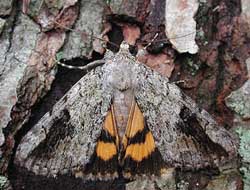
| ** 8876 Catocala micronympha, the Little Nymph Underwing, (wingspan: 35-50mm). John Himmelman image. Usual specimens have grey forewings shaded with green, brown, black and white tints. Usually a darkened band passing from costa through reniform spot to outer margin. High variability. Full size Joe Garris photo of C. micronympha form hero. |
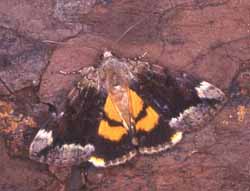
| ** 8876 Catocala micronympha
form gisela,
the Little Nymph Underwing, (wingspan: 35-50mm). |
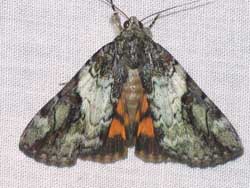
| ** 8876 Catocala micronympha
form hero,
the Little Nymph Underwing, (wingspan: 35-50mm).
The usual specimens have grey forewings shaded with green, brown,
black and white tints. There is usually a darkened band passing from
the costa through the reniform spot to the outer margin.
Form "hero" H. Edwards has a median area that is mostly white. |
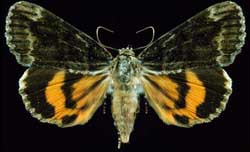
| ** 8876 Catocala micronympha form lolita, the Little Nymph Underwing, (wingspan: 35-50mm).Form "lolita" Sargent has very dark forewings. Harold J. Vermes image, used with permission from his son. |
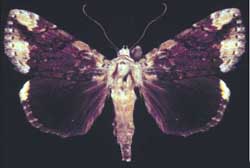
| ** 8876 Catocala micronympha form sargenti, the Little Nymph Underwing, (wingspan: 35-50mm). Usual specimens have grey forewings shaded with green, brown, black and white tints. Usually a darkened band passing from costa through reniform spot to outer margin. Form "sargenti" Covell (very rare) has a hindwing that is all black. |
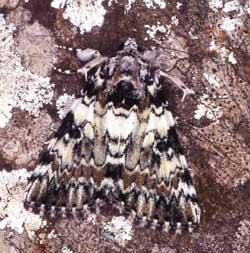
| ** 8877 connubialis, Connubial Underwing, (wingspan: 35-50mm). The forewing is highly variable and there are several different forms: "sancta" Hulst is the typical form and has forewings with white ground colour and sharply contrasting black lines and markings. There is also brown shading between post medial and subterminal lines; "cordelia" H. Edwards is coloured as above but markings are faint; "pulverulenta" Brower has grey-green forewings with faint markings, sometimes none; "broweri" Muller is the melanic form with forewings that are dark green, almost black. The hindwing has a separate anal spot and the outer band ends with a straight cut. |
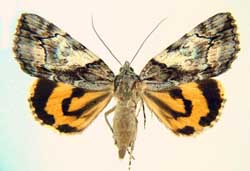
| Catocala pretiosa Precious Underwing; 40-50mm; unconfirmed; Quite similar to crataegi and mira, but pretiosa has considerable creamy white colouration in median area. Lower portion of basal area is light, not dark as in crataegi. Hw Inner black band forms loop; outer band is broken (not complete as in mira), followed by dot tapering to anal angle. |
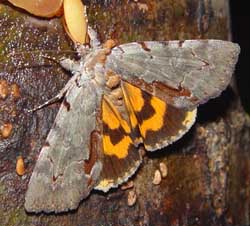
| ** 8864 Catocala grynea ; Woody Underwing, 40-50mm. The forewing is a dull greenish grey with orangey-brown shading along the inner margin. The antemedial, median and postmedial lines are quite faint. Praeclara is somewhat similar but has a break in the brown shading between the am and pm lines. Praeclara also has a paler orange hindwing color. Tim Dyson image. |
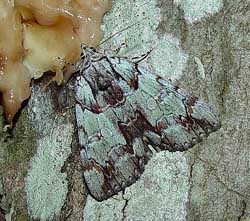
| ** 8865 praeclara; Praeclara Underwing, 40-50mm. Fw pale greenish-grey with considerable contrasting brown shading beyond pm line. Black basal dash very close to inner margin, and another dash, higher up in median area. Note contrasting shapes of reniform and subreniform spots. Upper of two larger pml teeth is longer, wider than lower tooth. Note double, white filled amls. Lighter, subcircular patch, outlined in black, brown on lower thorax. |
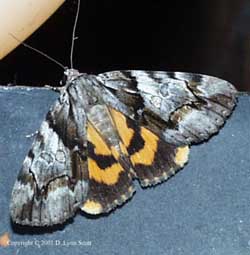
| ** 8867 Catocala blandula; Charming Underwing, 40-50mm. Pale basal area of forewing distinguishes mira from blandula (dark brown) and crataegi (black). Fw: dark contrasting lines as in crataegi. Considerable brown in subterminal area and subreniform spot is very conspicuous and usually brown. Light area runs obliquely from costa to subreniform spot. Hw: deep orange and has a complete inner black band. The outer black band is unbroken. Lynn Scott image. |
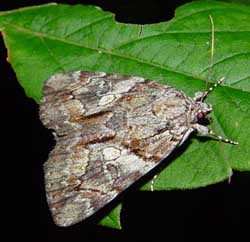
| Catocala mira; Wonderful Underwing, wingspan: 40-50mm. Pale basal area of fw distinguishes mira from blandula (dark brown) and crataegi (black). Fw lacks dark contrasting lines of crataegi and blandula. Considerable brown in subterminal area and subreniform spot very conspicuous, usually brown. Light area runs obliquely from costa to subreniform spot. Noticeable space along i. m. between antemedial and postmedial lines. Hw deep orange and has a complete inner black band. The outer black band is unbroken Tim Dyson image. |
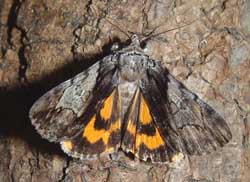
| ** 8858 Catocala crataegi; Hawthorn Underwing, 40-50mm. Determination is based on dark (black) shading in forewing basal area continuing along inner margin to anal angle and brown shading beyond postmedial line. There is also a definite greenish cast to median area. The lower wing has the outer black band, broken near the anal angle, distinguishing crataegi from blandula. Tim Dyson image. |
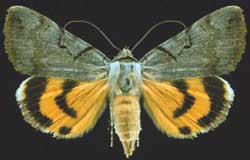
| ** 8841 Catocala abbreviatella; Abbreviated Underwing; 40-50mm. Fw uniformly colored with narrow black lines on anterior half. Brown reniform spot ringed with black. Hw outer black band abbreviated and then continued with dot. Inner black band terminates well before im. Similar species: C. nuptialis solid black reniform spot. C. whitneyi broad dark triangles mid fw. |
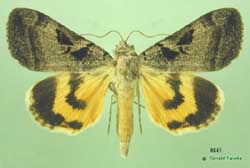
| ** 8843 whitneyi TM; Whitney's Underwing, wingspan 45-50mm. unconfirmed possibility for western Indiana Catocala whitneyi is similar to abbreviatella Grote, and nuptialis Walker, but generally flies later in the season where the species overlap. The two black wedges/triangles on the forewing, one over the reniform spot and the other just outside the antemedial line, distinguish whitneyi. Gerald Fauske image. |
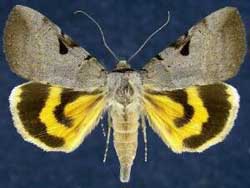
| ** 8842 Catocala nuptialis; Maried Underwing, wingspan 40-50mm. unconfirmed possibility The reniform spot is very dark, black or almost black on an otherwise faintly marked, almost uniformly grey forewing. The outer black margin of the hindwing is unbroken, but is indented near the anal angle.Jim Vargo image. ???????? |
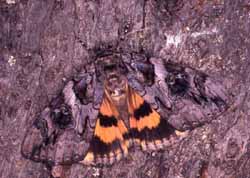 |
** 8844 amestris; Three-staff Underwing; wingspan 43-50mm. There is a large pale patch near the apex. In form "westcotti" the hindwing outer black band is complete. In other moths, the band is broken as in abbreviatella. Hindwing ground colour is usually deeper yellow-orange than in similar species. Leroy Simon image. |
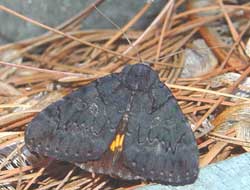
| ** 8775 antinympha;
Sweetfern Underwing, wingspan 45-55mm. |
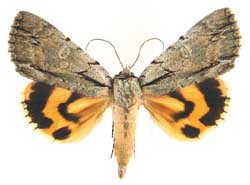
| ** 8772 clintoni; Clinton's Underwing, wingspan 45-55mm.The black basal dash distinguishes clintoni from illecta and abbreviatella, both of which lack the dash. Vernon Brou image. |
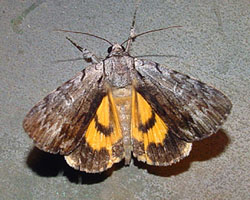
| ** 8772 gracilis; Graceful Underwing, wingspan 40-45mm.Gracilis closely resembles sordida but the hindwing loop is not complete in gracilis as it is in sordida. Gracilis also tends to have a darker inner margin and there is frequently (99% of the time, Dale Schweitzer, via Joe Garris), but not always, a basal dash. Sordida never has the basal dash. |
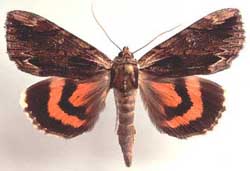
| ** 8857 Catocala ultronia; Ultronia Underwing, wingspan: 50-63mm.Fws typically gray-brown, with a distinct and very dark inner margin and characteristic light brown patch, underscored by very dark arc, near wingtip. Underwings can be yellow to orange to salmon. |
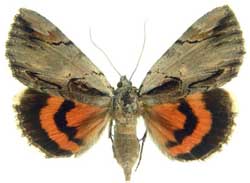
| ** 8857 Catocala ultronia form lucinda; Ultronia Underwing, wingspan: 50-63mm.In form lucinda most of the forewing is bright grey. On all forms there is
extensive orange-salmon colouration on hw ventral surface,
and there is a dark discal lunule. |
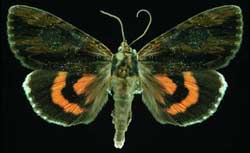
| Catocala ultronia, form nigrescens, the Ultronia Underwing, wingspan: 50-63mm. In the melanic form nigrescens, the dorsal forewing is very dark. Even darker subapical arc, basal dash and dash near anal angle are still visible. Dark basal hairs on hindwing. Harold J. Vermes slide, used with permission from his son. |
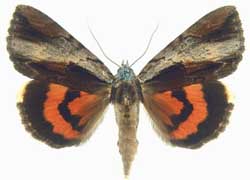
| Catocala ultronia form celia.
In form celia there is a wide, light grey band separating a dark region along inner margin and
a dark patch near the apex.
The ventral surface of forewings of all forms has a generous suffusion
of orange-salmon scales in the lower half of the median area. |
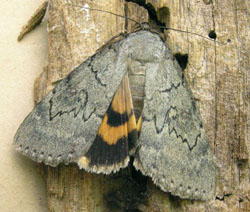 |
** 8779 serena Serene Underwing. 55-60mm. Head, collar and abdomen are brown while thorax is grey. Am and pm lines are thin but very dark and distinct on an otherwise drab, almost uniformly olive-grey forewing. Black marginal band of the lower wings is indented at the center, and relatively narrow, deep yellow median band parallels this indentation. Basal hairs are brown. Catocala serena courtesy of Carroll Rudy. |
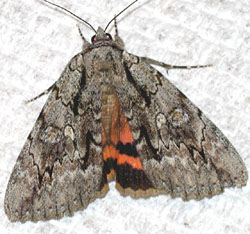
| #8778 Catocala habilis; 55-65mm. Note large "M" on thorax and "pork chop" shaped, light coloured subreniform spot that becomes very dark in its constriction at juncture with pme line. Pm line narrow but dark and distinct, outwardly lined with narrow suffusion of white scales, followed by broader band of brown scales, and then another broader suffusion of white scales up to very regular dentation of subterminal line. There is always significant "bleeding" of yellow-orange to salmon scales into hw fringes. Large reniform spot has brown center, faintly edged with black, then white, then black again. Joe Garris image. |
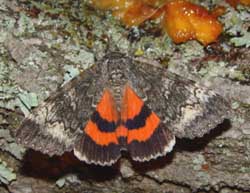
| #8817 briseis; Briseis Underwing; unconfirmed 60-70mm. Fws predominantly mottled dark-grey-brown with some lighter areas 1) between pm and subterminal lines, 2) at very base of am and pm lines along inner margin, and 3) over subreniform spot running diagonally toward costa. Pm lines do not have greatly elongated and sharly pointed "teeth" near apex. The hindwing fringe is white and unbroken and inner black band (fairly even) reaches inner margin. Tim Dyson image. |
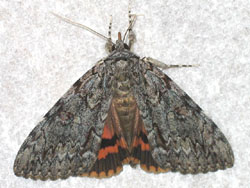
| #8795 Catocala palaeogama ; wingspan: 60-70mm. Subreniform spot closed, does not approach pm line, is smaller than in C. habilis. All forms have characteristic orange, heavily barred fringe to apex, and irregular bands on hws. Hw basal median area heavily suffused with dark brown to black scales. Dark bar in outer half of median area, paralleling i. m. halfway between i. m. and light, closed subreniform spot. Joe Garris photo. |
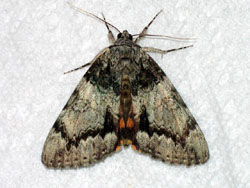
| #8795 Catocala palaeogama form phalanga; wingspan: 60-70mm. In this form, fw basal area and subterminal area are very dark against a much lighter background. Dark bar in the outer half of the median area, paralleling the inner margin halfway between the inner margin and the light, closed subreniform spot is especially evident. Joe Garris image. |
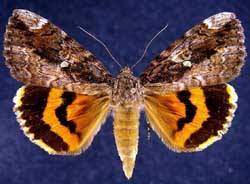
| ** 8770 Catocala innubens; Betrothed; 55-72mm. Forewing is mottled with white, grey and brown, and subrenifrom spot tends to be lighter in colour, although it is sometimes obscured by an indistinct blackish bar which runs from middle of basal/thorax connection to just below much lighter apex at outer margin.Jim Vargo image. |
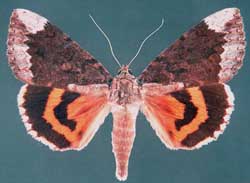
| ** 8770 Catocala innubens form scintillans; Betrothed; 55-72mm.In form scintillans most of the basal area (all but lower third) and all of the median area of the forewing is dark reddish brown. The area outside the pm line is grey. Vernon A Brou image. |
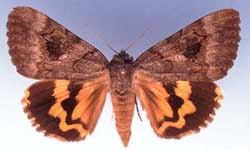
| ** 8772 Catocala consors WO; Consort, wingspan: 70mm plus. Fw with irregular am and pm narrow black lines. Dark patch outside the reniform and subreniform spots. The orange-yellow hindwing pm band tends to be narrow and irregularly zigzagged. Sometimes the band is wider and slightly less irregular. James K. Adams image. |
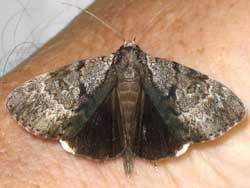
| Catocala andromedae, Gloomy Underwing, (wingspan: 40-50mm). Black underwings and dark grey fringe of hws, coupled with dark i.m. of fws help to identify this species. There is also a very dark "flying saucer" shape, adjoining subreniform spot to midpoint of am line. The "teeth" of pm line short and blunt, outwardly edged with white. Subterminal line is also outwardly edged with white. |
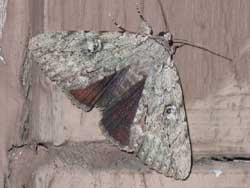
| ** 8781 judith, Judith's Underwing, 45-55mm; one of smaller "black" underwings. Fw uniform light grey with thin, only slightly darkened antemedial, median & pm lines. No darkened dashes (slight anal dash) or transverse lines. Reniform area slightly darkened while the area just before the subterminal line is a bit lighter. Note absence of hw white fringe. Joe Garris photo. |
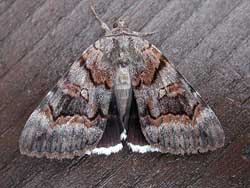
| ** 8773
Catocala epione ;
Epione Underwing, wingspan: 55-65mm |
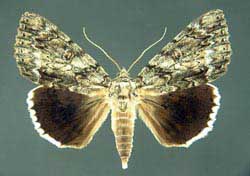
| Catocala ulalume, Ulalume Underwing, (wingspan: 65mm). Fw mottled light to dark grey, no strongly contrasting lines, dashes, bars. Aml ends at im in very light coloured crescent, close to pml. Open subrenifrom spot light coloured, "comma" shaped with triangular, somewhat bulbous head. Aml: short, thin, slightly humped dark line through midpoint. Hw black, fringe pure white, thin, pointed checking. |
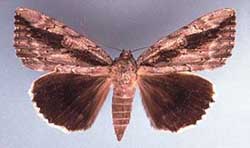
| ** 8782 Catocala flebilis ; Mournful, wingspan: 54-65mm. Diffuse black band runs from basal area to outer margin just below apex, interrupted by pale grey subreniform spot. Reniform spot filled with brown, additional brown outside postmedial line. No anal dash as in angusi. Hws have white fringe. |
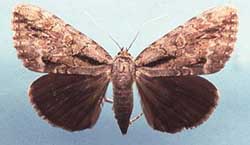
| ** 8783 Catocala angusi WO; Angus' Underwing, 60-74mm; Dark dashes/streaks in basal & anal areas distinguish angusi. Reniform spot: light brown filling. Hw fringe black except for white at apex. Form lucetta has broad black band from basal area to o.m., broken by reniform & subreniform spots. |
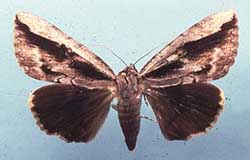
| ** 8783 Catocala angusi WO; Angus' Underwing, 60-74mm; Dark dashes/streaks in basal & anal areas distinguish angusi. Reniform spot: light brown filling. Hw fringe black except for white at apex. Form lucetta: broad black band from basal area to o.m., broken by reniform & subreniform spots. |
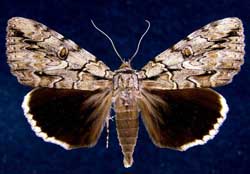
| Catocala luctuosa, Underwing, (wingspan: mm). Fw light grey (yellowish tint) clearly marked with a basal dash that continues with another dash through the am line, followed by another anal dash almost forming bar parallel to im. Hw fringe white, lightly barred at veins. Fw pml "teeth" elongated and dark, continuing dark dar emanating from om just below apex. |
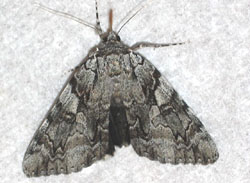
| Catocala dejecta; Dejected; wingspan 56-73mm. Pale grey patch from reniform and subreniform juncture to costal margin is diagnostic. Note open, light "pork chop" shape of subreniform spot. Two "teeth" in pml above subreniform spot are relatively short and blunt. Upper portion of aml thick and black; lower half has light rounded lobes outlined in black. Hw fringe is white with black wing veins extending like "teeth". |
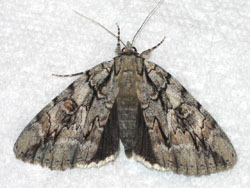
| Catocala retecta; wingspan: 60-75mm. Note light coloured, elongated and open subreniform spot which interrupts dark, diffuse ark running through center of wing from basal area (body-wing juncture) to fw apex. Center of reniform spot brown and there is a brown area just below costa running to inner margin just outside pm line. Off-white hindwing fringe only lightly checked along wing veins. Joe Garris image. |
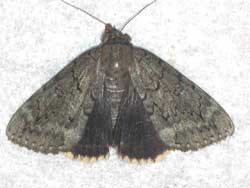
| ** 8784 obscura; the Obscure Underwing, (wingspan: 60-72mm), has dull, grey forewings, usually void of any significant dashes, streaks, providing for easy identification. Am, median and pm lines faint and subterminal line region is only slightly paler than rest of fw. Hw fringe is off-white, lightly checked on veins. Joe Garris photo. |
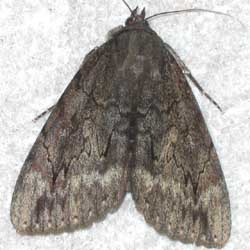
| Catocala residua; Residua Underwing, (wingspan: 60-73mm), distinguished from Catocala obscura by grey hw fringe of residua. Catocala obscura has white to off-white fringe and tends to be less common in northern portions of its range. Fw subterminal line/area of Catocala residua tends to be pale as is its open, elongated subreniform spot. Like C. obscura it is otherwise devoid of significant markings except for hint of dark bar running from basal area through reniform spot to o. m. just below apex. |
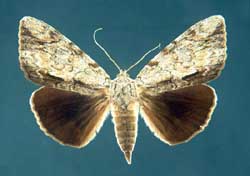
| ** 8791
Catocala insolabilis;
Inconsolable, wingspan: 65-75mm;
Fw light grey with blackish shading along inner
margin. Antemedial and postmedial lines are thin.
Hw fringe very narrow and grey, becoming whiter toward
apex.
Ventral surface clearly distinguishes insolabis, being almost
completely black except for some white in basal area. |
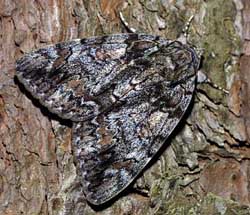
| ** 8794
Catocala lacrymosa;
Tearful Underwing, 60-82mm.
The forewing is highly variable with a mixture of black, brown
(wing tips and outside postmedial line) and dark grey scaling.
There are usually whitish crescents, along the inner margin at the
base of the antemedial and postmedial lines. |
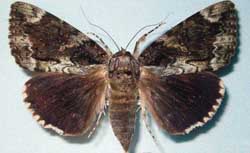
| ** 8794
Catocala lacrymosa;
Tearful Underwing, 60-82mm.
Form paulina: lighter grey post median area & area along and parallel to inner margin, in sharp contrast to
darker basal median areas. |
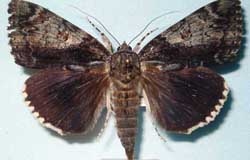
| ** 8794
Catocala lacrymosa;
Tearful Underwing, 60-82mm. |
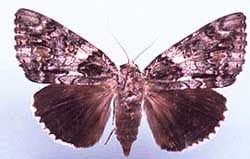
| ** 8794 Catocala lacrymosa; Tearful Underwing, 60-82mm;; GSMNP/TP/WAM/KC. In form albomarginata there is an abundance of white scaling on the forewing. |
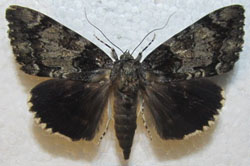
| ** 8794 Catocala lacrymosa; Tearful Underwing, 60-82mm;; TP. Form "zelica", has black basal patch and strong black subterminal line. |
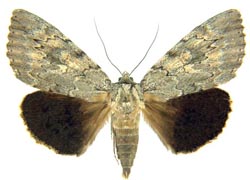
| ** 8780 Catocala robinsoni; 70-80mm. Fws relatively plain pale grey. Female has basal dash, absent in male. Currata French, 1882, female form: weak basal dash. Rare form missouriensis Schwarz, 1915: dark, broad bar extending from basal area to o.m. just below apex. Lighter grey rnfm, subrnfm spots break bar in missouriensis, found from PA. to FL. Hw fringe: White; bands on ventral surface prominent. |
Catocala robinsoni, Whitley County, Tim Loeffler
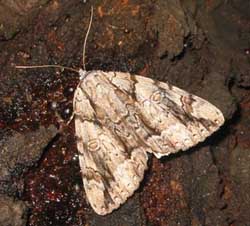
| ** 8792 Catocala vidua; Widow; 70-80mm. Fw ground colour light grey. Distinguishing dark arc runs through top of reniform spot to just below apex. Heavy, dark anal and basal dashes, connecting to dark median bar, running parallel to i. m. Am line thick, black in its upper half. Reniform spot with two almost concentric irregular ovals. Subreniform spot light, open, constricted as it meets pm line. Hw black with broad, white fringe, lightly interrupted. Marie Winn image. |
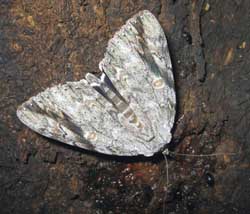
| ** 8793 Catocala maestosa, Sad Underwing, wingspan: 78-98mm. Maesotsa is quite similar to, although usually larger than, vidua. Both have the dark arc from the costa, above the reniform spot, to the outer margin just below the apex. Maesotsa, however, lacks the dark bar, found on vidua, parallel to the inner margin. The reniform spot is brown and there is brown shading just outside the postmedial line. The hindwing fringe is white, narrow and heavily barred. |
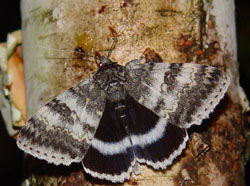
| ** 8803 Catocala relicta
;
Forsaken, White, Relict; 70-80mm:
Considerable variation with regard to black/white
concentrations on fws. |
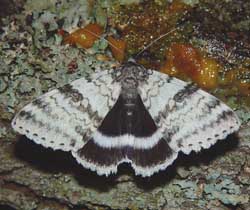
| ** 8803 Catocala relicta ; Forsaken, White, Relict; 70-80mm: Considerable variation with regard to black/white concentrations on fws. Form clara: basal and subterminal areas predominantly white.Typical specimens have basal and subterminal areas with blackish scales. Black hws, with brilliant even white inner band and white fringe, are distinctive. June until October. |
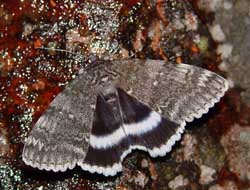
| ** 8803 Catocala relicta ; Forsaken, White, Relict; 70-80mm: Considerable variation with regard to black/white concentrations on fws. Form phrynia: evenly dusted with grey over entire forewing. Typical specimens have basal and subterminal areas with blackish scales. Black hws, with brilliant even white inner band and white fringe, are distinctive. June until October, poplars and willows |
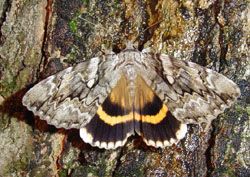
| ** 8802 Catocala cerogama; Yellow-Banded; 70-80mm. There are several different forms. The pm line is distinct, dark and has an elongate pair of projections. The pm and am lines meet the inner margin in relative proximity. The closed subreniform spot it lighter than surrounding areas, and it is shaped a bit like an arrowhead with the point toward the body. The hindwings are distinctive. Jean-Benoît Duval image. |
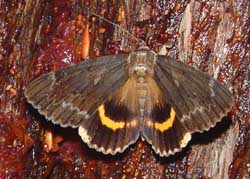
| ** 8802 Catocala cerogama; Yellow-Banded; 70-80mm.Form ruperti: Forewings are almost uniform grey-brown with white scales outlining subterminal line. The hindwings are distinctive. Tim Dyson image. |
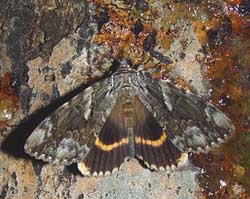
| ** 8802 Catocala cerogama; Yellow-Banded; 70-80mm.Form bunkeri: Forewings are dark in median and basal areas. Hw golden band is reduced in thickness. Basal hairs are brown instead of yellow. The hindwings are distinctive. Tim Dyson image. |
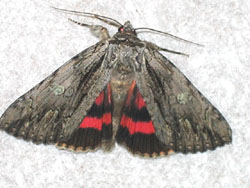
| ** 8851 Catocala coccinata; Scarlet; 57-70mm. There are usually diffuse basal and anal dashes on an otherwise light grey, mottled fw. Hindwing fringe is white (often with some salmon scaling) and is heavily checked. I find "tooth" just below pair of very elongated "teeth" is much reduced and is quite rounded, usually allowing considerable room for lighter patch of scales. Dark bar crosses thorax. Reniform spot tends be to light, often with greenish cast. Joe Garris image. |
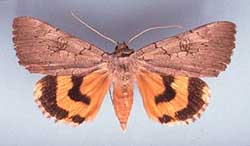
| ** 8840
Catocala illecta;
Magdalen Underwing, wingspan: 60-70mm |
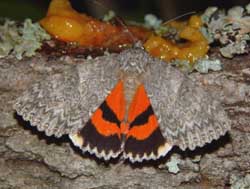
| ** 8822 meskei TM; Meske's Underwing; 65-75mm. Fws less distinctly marked compared to unijuga, some red-orange at the hindwing apex and just inside the fringe along the outer margin in meskei that is lacking in unijuga. Fw subreniform spot is opened or connected to the postmedian line. The hindwing postmedian band nearly straight, turned in and tapering near anal angle. Tim Dyson image. |
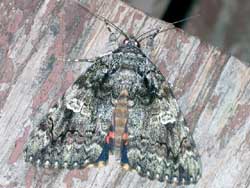
| ** 8801 Catocala ilia; Ilia; wingspan: 65-82mm. Several different forms, most have characteristic white area in and around reniform spot. Diffuse dark arc running from this spot to just below apex. Subreniform spot squarish, concave inner and outer edges and elongated constriction connecting it to pml. White dots near fw om in character with the overall "contrasting" appearance. |
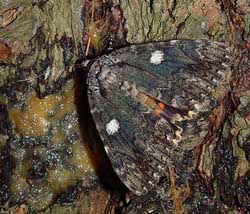
| ** 8801 Catocala ilia; Ilia; form conspicuaIn this form the entire reniform spot is heavily suffused with white scaling on an otherwise darker ground colour. Hence the form name "conspicua". Tim Dyson image. |
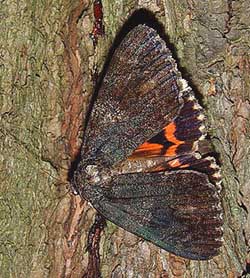
| ** 8801 Catocala ilia; Ilia; form satanasIn this melanic form the entire forewing, including the reniform spot is very dark. Hence the form name "satanas". The dark basal streak is still evident on this form. Tim Dyson image. |
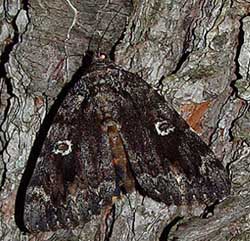
| ** 8801 Catocala ilia; Ilia; form normaniIn this semi-melanic form the entire forewing, excluding the reniform spot, is relatively dark. The brownish, kidney-shaped center of the reniform spot is outlined in white. The basal streak and subapical arc are still visible. Tim Dyson image. |
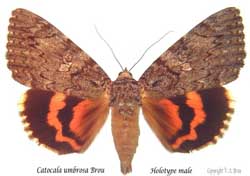
| ** 8857.1 Catocala umbrosa; mm; Double brown am line, inward line fainter, filled with off white; reniform spot brown center outlined in black , off white and black again; subreniform, large, pale brown, closed. Pm line wit htwo elongated upper teeth, next tooth reduced, next two progressively longer, rounded, final lobe rounded and shorter. HW with dark scaling/hairs in basal median area along im |
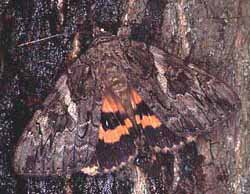
| ** 8771 Catocala piatrix ; Penitent, wingspan: 68-84mm. Fw: light-colored band/bar extending from light coloured, triangular subreniform spot along am line to costa. Brown, kidney-shaped reniform spot surrounded in pale grey, outlined in black, usually with distinct black along wing veins in a dark area outside the reniform spot. Hw: fringe lightly barred; lighter in color than deeper orange on rest of wing. |
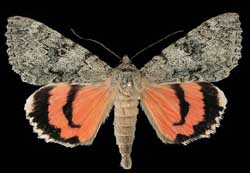
| Catocala junctura; Joined Underwing; 67-85mm. Fw is usually dark brownish-gray to evenly powdered blue-grey w/o significant markings. Doubled reniform spot often obscure. Thin, slightly darker am and pm lines run from costa to im, not widely spaced at im. Hw salmon/ orange-pink, narrow inner black band turns in sharply, does not meet dark-haired im. |
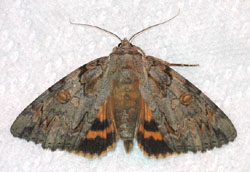
| ** 8798 Catocala neogama; wingspan 70-85mm. Brown head, thorax, larger size as compared to C. palaeogama. Neogama tend to be slightly smaller than subnata, have darker grey brown fws with more pronounced markings. Examination of hind tibia needed for id. Neogama's: flattened, unevenly, sparsely spined; subnata's: cylindrical, spines dense, uniform in distribution. Joe Garris photo. |
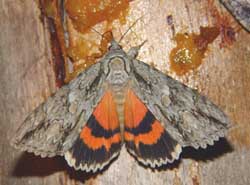
| ** 8806 Catocala parta; Mother Underwing, wingspan: 70-85mm. The black dashes in the basal, subapical and anal areas help to identify this species. The hindwings may be yellow to yellowish-orange but more often are salmon-red. Note the face-head-like markings on the thorax. In the hindwing, the first (nearest the apex) black protrusion into the white fringe is "noticeably" larger than the others. |
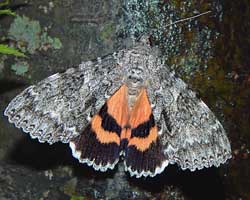
| ** 8805 unijuga; Once-married; wingspan: 70-90mm: Catocala unijuga has a fairly wide black inner band (almost reaching inner margin) in hindwing and very distinctive patterning in forewing. Meskei tend to have narrower band and dustier (less distinct) looking forewing. Semirelicta tend to have inner bands that terminate well before inner margins. Also note the very white fringe on both the forewings and hindwings. Carroll Rudy image. |
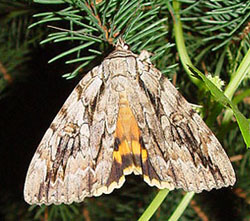
| ** 8797 Catocala subnata; Youthful Underwing: 75-90mm. Fws greyish white with blue-grey and light brown scales, usually with hws brighter yellow than those of neogama. Neogama usually have basal dash; absent in male subnata, but present in females. Magnification of hind tibia needed for id: subnata: cylindrical hind tibia; neogama: compressed or flattened hind tibia. subnata: ventral surface of tibia densely covered with evenly distributed spines; neogama: ventral surface of tibia sparsely covered. |
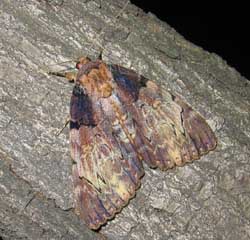
| Catocala nebulosa; Moths have prominent dark brown upper-half-basal patch that extends to and ends at antemedial line. Apical area also tends to be brown, much darker than median area but not as dark as basal patch. The anal angle also has the darker brown scaling. The pm line is distinct near costa and inner margin, but becomes weak between the two. It meets inner margin in relative close proximity to am line. Closed subreniform spot is large and connects to the pm line via a thin line. |
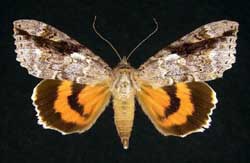
|
** 8804 C. marmorata;
Marbled; wingspan 85-95mm |
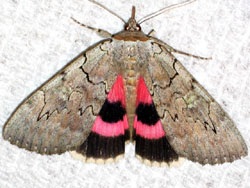
| ** 8833 concumbens Sleepy Underwing or Pink Underwing; 60-75mm. This brown thoracic collar is quite evident in this image as is the interruption in the pm line by the open subreniform spot. The white hindwing fringe is only lightly checked on the wing veins. The vibrant pink bans are distinct in colour and also in their relatively smooth contour. |
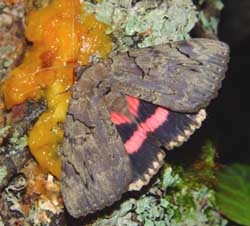
| ** 8832 Catocala cara; Darling; wingspan 70-85mm. Note deep maroon almost purple cast to fwis, mixed with very pale green. Lower half of am and pm lines is barely visible. No distinctive bars or dashes. The two upper "teeth" on pm line are thin and long. Hw bands are pink. Heavy black checking on off-white hindwing fringe. Relatively thick black median band of hw almost reaches inner margin which is usually heavily adorned with dark hairs. Tim Dyson image. |
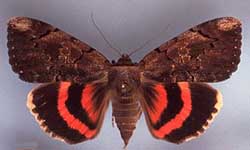
| ** Catocala carissima; wingspan 70-85mm. Distinct light grey brown area at fw apex, preceded just inside pm line by slightly darker patch. Am and pm lines sharp and dark. Hw inner black band wide, complete, merges with extensive grey-black scaling along im. Hw fringe cream coloured. |
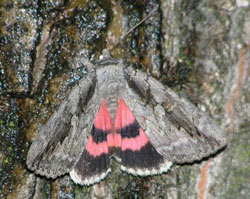
|
** 8834 amatrix Sweetheart Underwing; (wingspan 75-95mm). Very skittish, frequently hides in caves, under bridges, under tree bark, etc. by day, resting with head down. Hw patterning and colouration similar to that of C. concumbens, but large size (wingspan 75-95mm) and dark bar running from basal area to just below apex distinguishes C. amatrix. See large Catocala amatrix courtesy of Joan F. Rickert. |
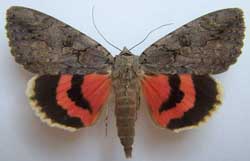
|
** 8834 amatrix form selecta
Sweetheart Underwing; (wingspan 75-95mm) |
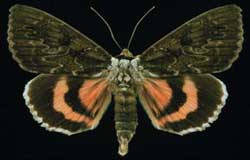
|
** 8834 amatrix form hesseli
Sweetheart Underwing; (wingspan 75-95mm) |
Catocala serena *
Catocala grynea *
Catocala ultronia *
Catocala connubialis (More common in Light Traps) *
Catocala ilia *
Catocala neogama (Abundant) *
Catocala subnata (Early!!) *
Catocala innubens *
Catocala palaeogama *
Catocala coccinata *
Catocala cara *
Catocala relicta *
Catocala clintoni *
Catocala parta *
Return to Canadian Index
Return to Main Catocala Index
Enjoy some of nature's wonderments, giant silk moth cocoons. These cocoons are for sale winter and fall. Beautiful Saturniidae moths will emerge the following spring and summer. Read Actias luna rearing article. Additional online help available.
Use your browser "Back" button to return to the previous page.
This page is brought to you by Bill Oehlke and the WLSS. Pages are on space rented from Bizland. If you would like to become a "Patron of the Sphingidae/Catocala Sites", contact Bill.
Please send sightings/images to Bill. I will do my best to respond to requests for identification help.

|
butterfly to the left, a link to many worldwide insect sites. |
Scott Mescher reports the following from Jay County, central eastern Indiana for the summer/fall of 2009.
He writes on October 2, 2009: "The weather here has changed to cool and wet with nighttime temps in the low forties. I have not seen any Catocala since September 26th and this will probably be the last unless we have a warm front come in. This should give me some time to get a few more spread and also get some measurements for you."
The form counts are included in the species count, so all angusi recorded (four) were form lucetta (four); three of the twenty-three amatrix recorded were form selecta.
|
Use your browser "Back" button to return to the previous page.